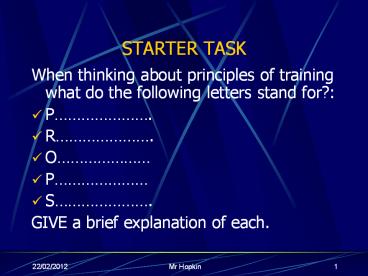STARTER TASK - PowerPoint PPT Presentation
1 / 15
Title:
STARTER TASK
Description:
The American College of Sports Medicine (ACSM) (2000) which is the gold standard ... to acquire and maintain fitness levels is 3 to 5 sessions per week (ACSM, 2000) ... – PowerPoint PPT presentation
Number of Views:65
Avg rating:3.0/5.0
Title: STARTER TASK
1
STARTER TASK
- When thinking about principles of training what
do the following letters stand for? - P.
- R.
- O
- P
- S.
- GIVE a brief explanation of each.
2
STARTER TASK ANSWERS
- Progression training should get progressively
harder to get fitter. - Reversibility if we dont continue to train it
we lose it. - Overload the body must go through overload
(work harder than normal) in order to progress - Peaking Peaking is about ensuring that targets
are achieved at the correct time. - Specificity training should be specific to the
players chosen event.
3
PHYSICAL EDUCATION DEPARTMENT
- F.I.T.T PRINCIPLES OF TRAINING
4
LEARNING OUTCOMES
- Know the F.I.T.T. principles of training and
their associated elements. - Understand the definition of each training
principle. - Know how they can be applied for different games
activities.
5
PRINCIPLES OF TRAINING 1
- Overload and FITT principles.
- Remember that
- In order to achieve progression the body must go
through overload. - This is achieved by following the FITT principle
- Frequency.
- Intensity.
- Time.
- Type.
- Remembered by the pneumonic F.I.T.T.
6
PRINCIPLES OF TRAINING 2
- The American College of Sports Medicine (ACSM)
(2000) which is the gold standard to work by
recommends - - Frequency - 5 to 7 times a week
- Intensity moderate (70 mhr)
- Time (duration) - 30 mins
- Type specific to aims or goals.
7
PRINCIPLES OF TRAINING 3
- Frequency.
- This is the number of times an individual trains
and will depend on current level of fitness. - Deconditioned (unfit) individuals may gain
benefit from twice weekly sessions. - International athletes may train twice a day
seven days a week. - Optimal training frequency to acquire and
maintain fitness levels is 3 to 5 sessions per
week (ACSM, 2000).
8
PRINCIPLES OF TRAINING 4
- Intensity.
- How hard you exercise and the amount of energy
needed to perform an exercise or activity. - This will be based on the aims or goals of the
athlete. - For improvement to occur the HR must be raised
above 70 of the maximum heart rate (MHR). - For the professional athlete it should be at
least as hard if not harder than they will find
in competition (85 to 110 MHR).
9
TASK
- MHR is calculated by
- Subtracting the age from 220
- The MHR for a 18year old would be 202BPM.
- i.e. 220 18 202.
- 70 of this would be approx 140BPM.
- Formula 202MHR X 70 100
- Work out the MHR and 70 for a 20, 40,60 and 80
year old using the above formula.
10
TASK ANSWERS
- The MHR for a 20year old would be 200BPM 70
140BPM. - The MHR for a 40year old would be 180BPM 70
126BPM. - The MHR for a 60year old would be 160BPM 70
112BPM. - The MHR for a 80year old would be 140BPM 70
98BPM.
11
PRINCIPLES OF TRAINING 5
- Time (duration).
- The refers to duration or amount of time spent
training in each session or week. - This depends on current fitness levels and goals.
- For people new to exercise this may be as little
as 20 to 30mins a day. - International athletes frequently train between
two or three hours in a session. - They may also train 2 to 3 times a day.
12
PRINCIPLES OF TRAINING 6
- Type
- This will depend on the aims or goals of each
individual. - For general fitness it may consist of a badminton
or aerobics class. - For those training at an higher level the
activity must reflect the needs of the sport. - The training must be developed from general
fitness to specialised activity.
13
TASK 2
- In team games such as football, rugby or
basketball after general fitness what type of
activity would the players need to undertake? - What type of activity would gymnasts such as
parallel bars or the beam work on?
14
TASK 2 ANSWERS.
- Tactical approaches or set pieces.
- The mount and dismount.
15
HOMEWORK
- Gordon is a member of the under-16 gymnasts club.
- He wishes to improve his vaulting this year, can
you - Identify and explain 2 components of fitness
which are important to vaulting? - Identify 2 training principles he will need to
follow during the year?































